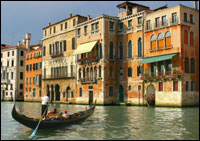
Don’t let Beantown become a has-been town.
Buckle your seatbelts: it’s going to be a wet ‘n’ wild ride. That’s the prediction — or, rather, the certainty — that today’s global warming carries. Erratic and unpredictable weather is en route, and coastal areas are among the places destined to be hardest hit. So why are Americans paying so little heed?
As scientists and weather pundits survey the winds of change destined to bounce our thermostats and pivot our climate, the political will of the nation seems becalmed. With change now the constant, it is high time and high tide to contemplate the fate of the half of our population who live on the nation’s coasts.
Recently, an EPA-funded study predicted that massive coastal flooding could radically alter the landscape of Boston, my home city, by the end of this century. The Hub, which prides itself on the “if-you-don’t-like-it-wait-a-minute” changeability of its weather, is not alone: the East Coast’s problem is America’s predicament, and the world’s. Alas, few U.S. residents have yet to seriously consider the message.
“We should take serious steps and a multifaceted approach now if we’re going to avoid trouble a century from now,” said Conservation Law Foundation head Philip Warburg in response to the 160-page report, which not only underscored the coming threat, but included graphics showing how surging seas would affect some of the city’s streets and landmarks. “We need an industrial-scale renewal.”
For all the efforts of Warburg and others, the study seemed to galvanize neither city officials nor citizens. I heard not a word on, say, patching the battered Charles River Dam Bridge, nor on combating an overflowing Charles River or Boston Harbor. Not a word about preventing distress to the institutions facing a soggy tomorrow, including Mass General Hospital, the Public Garden, and the Esplanade. Not a nod to a city’s worth of historic structures built on mudflats, nor plans to protect the already-leaky Big Dig tunnel, which houses the city’s major artery, or the vulnerable subway nearby.
Indeed, an opposing attitude toward the shores prevails. Real-estate pages throughout New England and elsewhere continue to feature developer portraits of forthcoming buildings jutting toward the ocean, as if the future were a mirage. To be realistic, these seaside images should portray ground-floor tenants peering through their underwater windows, eyeball to eyeball with passing fish and flapping seaweed.
Though developers are missing the boat, scientists are stepping in. In January, a gathering at the New York Academy of Sciences discussed the toll of climate change on their sea-wrapped metropolis, and the literal barriers that might ward it off. What’s an island “nation” like Manhattan to do in the face of rising waters and storm surges? This was the question posed by Douglas Hill, an engineer who edited The Baked Apple: Metropolitan New York in the Greenhouse almost a decade ago, and is still (and maybe more) anxious today. Hill and Malcolm Bowman, an oceanography professor from the State University of New York-Stony Brook, shared the platform to discuss the chances of protecting the populated urban shore.
Their presentation offered a glimpse of tomorrow’s weather events, when hurricanes, packing the extra wallop of the changed climate, would combine with rising waters. That mounting height and flooding would construct an inescapable situation, Hill observed. “When do you plan for a flood?” the scientist-scholar asked. The answer to this classic question: “Too late.”

When in foam, do as the Venetians do.
Attempts to defend these fragile shores are getting off the ground in places — from New Bedford, Mass., which has long relied upon a rocky hurricane barrier, to New Orleans, which struggles to find ways to protect its precarious perch below sea level. In Europe, Venice introduced adjustable barriers to prevent tidal flooding. The Netherlands, a parent of water protection, has constructed barricades, places for inland flow to run off safely, and even amphibious houses that bob up and down as the seas come and go, Hill pointed out.
But barriers are not enough. We need to be creative about alternatives, endorsing efforts like the New England governors’ and eastern Canadian premiers’ work to implement CO2 reductions, and Portland, Ore.’s success in shrinking emissions to levels of a decade and a half ago. We need fossil-fuel alternatives and conservation, not rich self-protectionists tiffing at offshore wind turbines. We should, as Warburg says, pursue an industrial-scale energy shift, and we must reduce consumption. We must mitigate and guard against rising seas. And though Washington retreats, this nation — which contributes 25 percent of the world’s carbon emissions — should, at the very least, join the rest of the industrial world in following the Kyoto Protocol.
If we protect our shores, we protect ourselves. The need is great, and the only thing weirder than the weather is the fear or myopia that stops us from acting. If our Wordsworthian “getting and spending” chokes our initiative as it has cloaked our world, then we’ll have sunk our planet — and ourselves.


